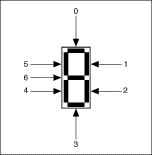IMAQ Read LCD VI
Owning Palette: Instrument ReadersInstalled With: NI Vision Development ModuleReads an LCD display in an input image using the descriptor of the ROI calculated by the IMAQ Get LCD ROI. IMAQ Read LCD returns the number as a double and as a string. The Segments status output indicates whether the number is recognized properly or any of the digits are not recognized fully. This output returns the status of each of the digits in the display. This VI reads LCD or LED indicators and tolerates light drift.




 |
LCD/LED (LCD) is a Boolean that controls the indicator type. FALSE corresponds to LCD indicators, and TRUE corresponds to LED indicators. The default is FALSE. |
||||||||||
 |
Image is a reference to the source image. |
||||||||||
 |
ROI Descriptor is a descriptor that defines the region of interest that contains the quadrilaterals surrounding each digit. The ROI is calculated by the IMAQ Get LCD ROI VI.
|
||||||||||
 |
Threshold is the threshold that determines whether a segment is ON or OFF. A segment is considered ON if the standard deviation of the pixels along a line profile across the segment is greater than this threshold. Increase this value when using images with high contrast. Lower this value when using images with low contrast. The default is 8. |
||||||||||
 |
Search Sign indicates whether the algorithm must read the sign of the indicator. |
||||||||||
 |
error in (no error) describes the error status before this VI or function runs. The default is no error. If an error occurred before this VI or function runs, the VI or function passes the error in value to error out. This VI or function runs normally only if no error occurred before this VI or function runs. If an error occurs while this VI or function runs, it runs normally and sets its own error status in error out. Use the Simple Error Handler or General Error Handler VIs to display the description of the error code. Use error in and error out to check errors and to specify execution order by wiring error out from one node to error in of the next node.
|
||||||||||
 |
Search Decimal Separator determines whether to look for a decimal separator after each digit. The default is FALSE. |
||||||||||
 |
Output string contains the number that has been read from the display. If the decimal separator is ON and the control Search Decimal Separator is TRUE, it is represented in the string by a dot (.) symbol. |
||||||||||
 |
Output value contains the value of the number represented by the display. |
||||||||||
 |
Segments status is an array of clusters containing the state of the segments of each digit. The order of the cluster is illustrated below.
|
||||||||||
 |
error out contains error information. If error in indicates that an error occurred before this VI or function ran, error out contains the same error information. Otherwise, it describes the error status that this VI or function produces. Right-click the error out indicator on the front panel and select Explain Error from the shortcut menu for more information about the error.
|
Examples
Refer to the following for an example that uses this VI.
- LabVIEW\examples\Vision\3. Applications\LCD Example.vi








